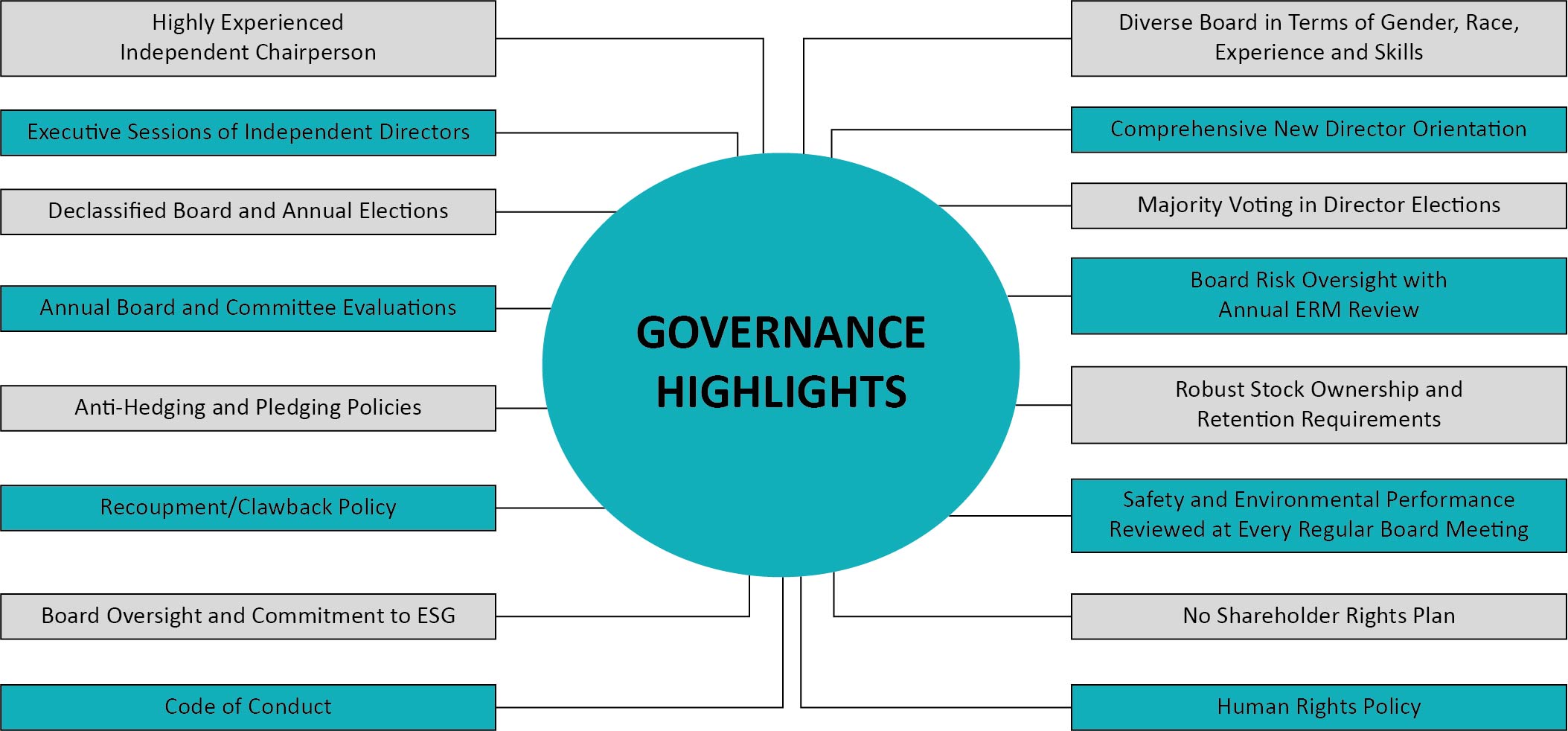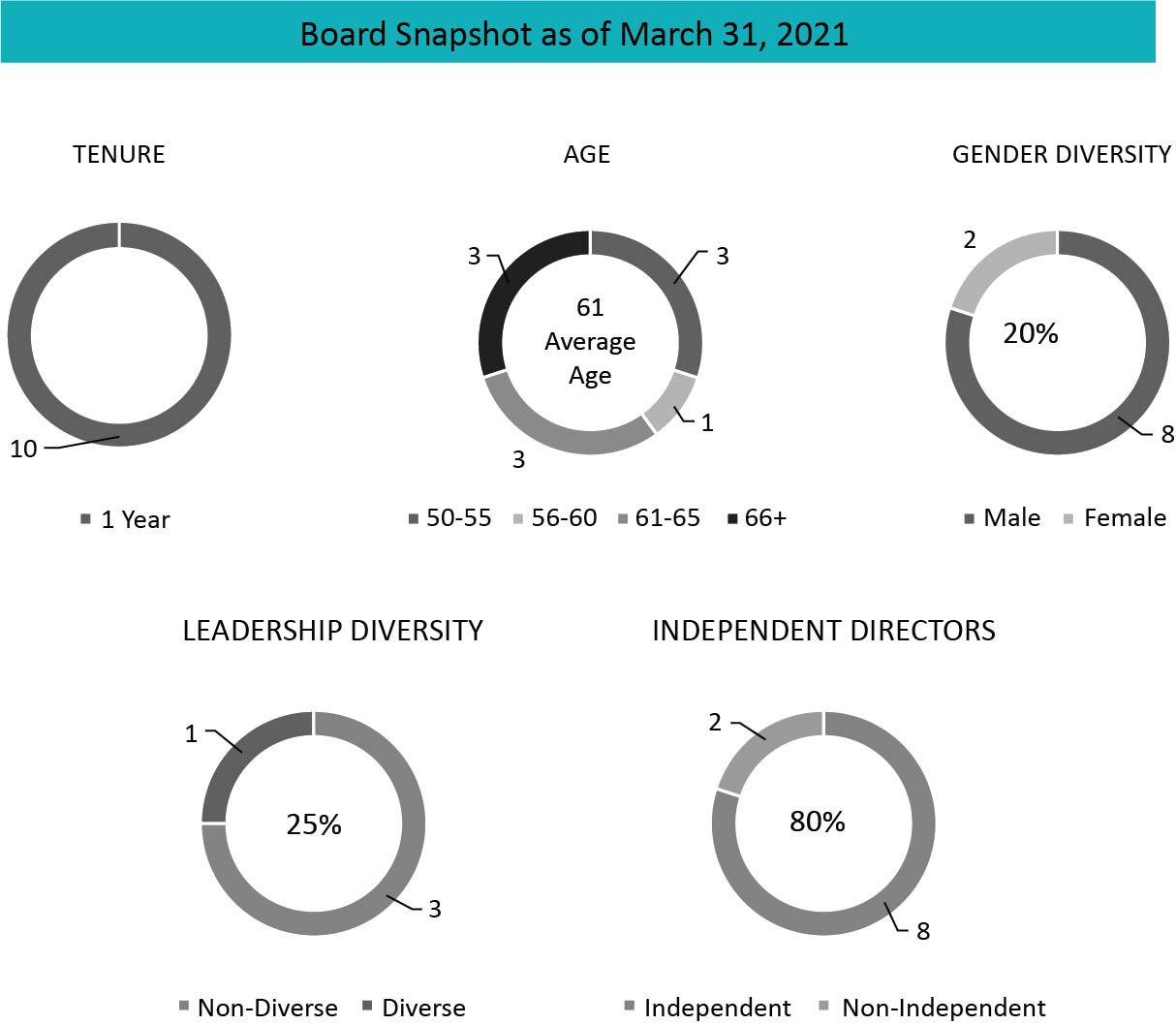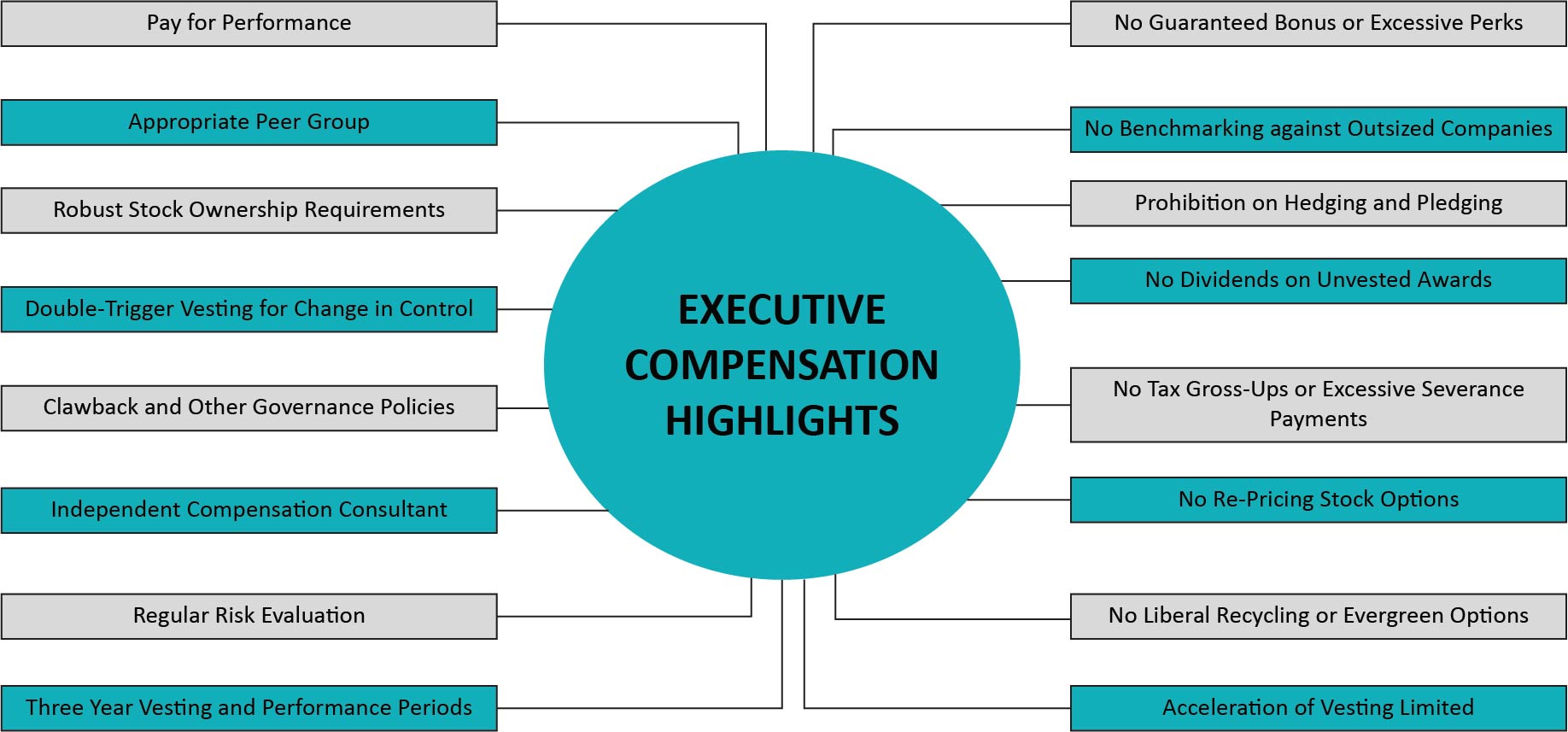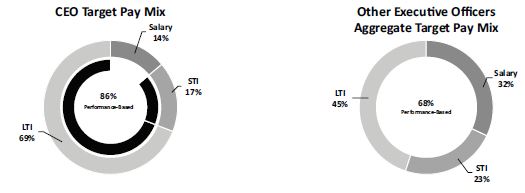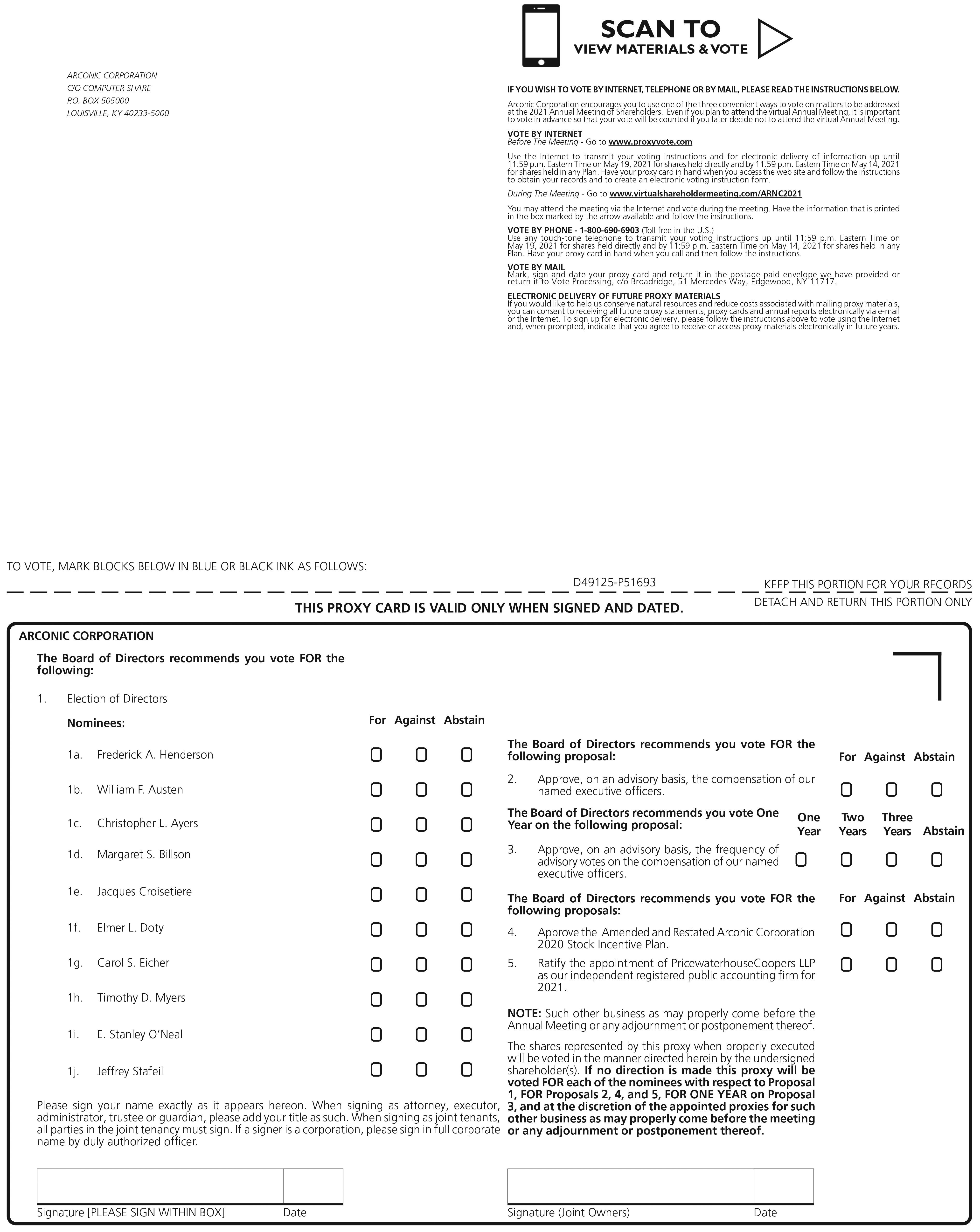| | | |
| | The Board
of Directors recommends a vote “FOR”“FOR” the approvalratification of the Amended and Restated
Arconic Corporation 2020 Stock Incentive Plan. |
Outstanding Awards
Set forth below is information regarding awards currently outstanding under the Stock Plan as of March 26, 2021 (except with respect to column (c)).
| Type of Award | | Granted
(a) | | Fungible Share
Accounting
Assuming Shares
Issued for All
Granted Awards (2)
(b) | | Elimination of
Fungible Share
Accounting
(estimated for all
shares granted
but not issued on
May 20, 2021) (3)
(c) |
| Stock options outstanding (1) | | 762,875 | | 762,875 | | 762,875 |
| Weighted average exercise price | | | | $25.46 | | |
| Weighted average remaining contractual life | | | | 3.2 years | | |
| Restricted share units outstanding (unvested) (1) | | 3,440,735 | | 5,161,103 | | 3,449,643 |
| Shares remaining for grant under the Arconic Corporation 2020 Stock Incentive Plan (4) | | | | 573,301 | | 2,277,347 |
| (1) | Includes stock options and restricted share units granted under the Stock Plan to satisfy the automatic adjustment and conversion, in accordance with the Employee Matters Agreement dated March 31, 2020 by and between Arconic and ParentCo of awards granted by ParentCo with respect to ParentCo common stock prior to and in order to effect the Separation. The number of restricted share units is presented in columns (a) and (c) without applying the fungible share accounting in effect under the Stock Plan, but eliminated under the Amended Stock Plan, where each share issued pursuant to a restricted share unit was counted against the share reserve as 1.5 shares. |
| (2) | Shares are presented after applying the fungible share accounting in effect under the Stock Plan but eliminated under the Amended Stock Plan, under which each share issued pursuant to a stock option or SAR under the Stock Plan was counted against the share reserve as one share, and each share issued pursuant to a restricted share or restricted share unit (“full value award”) was counted as 1.5 shares. |
| (3) | Shares available are presented without applying the fungible share accounting in effect under the Stock Plan but eliminated under the Amended Stock Plan. Each share issued pursuant to any form of award on or after the date of shareholder approval of the Amended Stock Plan will reduce the number of shares reserved under the Amended Stock Plan by one share. |
| (4) | Shares remaining in column (b) assume all remaining awards granted are restricted shares or restricted share units. |
For additional information regarding stock-based awards previously granted, see Note K to the Company’s Consolidated Financial Statements in the Company’s Annual Report on Form 10-K for the year ended December 31, 2020.
Increase in Share Reserve and Elimination of Fungible Share Accounting
As indicated in the table above, as of March 26, 2021, we have only 573,301 shares available for future awards under the Stock Plan. Taking into account the 1:1.5 fungible share accounting in effect under the Stock Plan, this translates into only 382,200 shares available for the grant of full value awards.
As a result of the limited number of shares remaining available for issuance under the Stock Plan, and in order to have an appropriate number of shares available for future equity awards, on recommendation of the Compensation Committee, the Board approved an increase in the number of shares reserved for issuance under the Amended Stock Plan of 3,000,000 shares and the elimination of the total fungible share accounting under the Stock Plan. Under such fungible share accounting, the Stock Plan assigned a ratio for counting usage of shares so that each share issued pursuant to a stock option or SAR was counted against the share limit as one share of common stock, and each share issued pursuant to an award of restricted shares, restricted share units or other awards (that is, full value awards) was counted against the share limit as 1.5 shares of common stock. Under the Amended Stock Plan, all shares issued pursuant to the exercise or settlement of awards outstanding as of the date
of shareholder approval of the Amended Stock Plan or granted under the Amended Stock Plan will be counted against the share limit as one share, regardless of the type of award. This change will boost the grant capacity of the shares available under the Amended Stock Plan with respect to the grant of full value awards.
In making these determinations regarding the share reserve and the share counting approach under the Amended Stock Plan, the Board considered our prospective equity compensation needs in view of our historical granting practices and our burn rate (as explained below), as well as the dilutive impact of the Amended Stock Plan to our shareholders. The Board also considered information published by institutional advisors, including their proxy voting guidelines.
Our potential dilution, or “overhang,” from outstanding awards and shares available for future awards under the Amended Stock Plan is approximately 8.6% (basic dilution). For this purpose, dilution is calculated as a percentage, where the numerator is the sum of the approximately 2,277,347 shares reserved under the Stock Plan for granting of future equity awards if the removal of the fungible share accounting is approved by shareholders, plus the 4,212,518 shares subject to outstanding option and RSU awards, plus, for purposes of the estimated future dilution, the 3,000,000 new shares that would be added if our Amended Stock Plan is approved by shareholders, in each case as determined without using fungible share accounting, and the denominator is the number of our shares of common stock outstanding. On a fully diluted basis (whereby the total of the numerator above is also added to the number of our shares of common stock outstanding in the denominator), the potential dilution would be 7.9%.
Based solely on the rate at which we have granted awards to date under the Stock Plan, while factoring in the proportion of such awards that were converted awards, and assuming that future awards under the Amended Stock Plan would be made at approximately the same rate, the total number of shares available for grant under the Amended Stock Plan is calculated to last approximately five years. However, the amount of awards granted in the past is not necessarily indicative of the amount that may be granted in the future. The amount of future grants is not currently known and will depend on various factors, including but not limited to the stock price of our common stock on the future dates of grant, the volatility of the stock and prevailing market conditions, as well as the growth of our employee population and our future grant practices.
Material Changes to the Stock Plan
The following summary highlights the proposed material changes to the Stock Plan.
| ● | The number of shares reserved for issuance pursuant to awards granted under the Amended Stock Plan has been increased by 3,000,000 shares to an aggregate of 11,500,000 shares since the inception of the Stock Plan in April 2020. |
| ● | The Stock Plan’s fungible share accounting, under which each share issued pursuant to a full value award was counted against the share reserve as 1.5 shares, has been eliminated with respect to outstanding and future awards, with the result that, as of the date of shareholder approval of the Amended Stock Plan, any share issued pursuant to a full value award, or any other award under the Amended Stock Plan, will be counted against the share reserve as one share (and will be returned to the share reserve as one share in the event of forfeiture of the award). |
| ● | With the additional shares and elimination of the fungible share accounting, approximately 5.28 million shares would be available under the Plan following shareholder approval. |
Other Changes to the Stock Plan
In addition to the changes noted above, the amendments include the following, as well as other administrative, clarifying and conforming changes:
| ● | The clawback provision of the Stock Plan has been revised to align the Amended Stock Plan with the Company’s Compensation Recovery Policy, including to extend the clawback to all plan participants (rather than executive officers only), specify the period (36 months) over which awards, shares and related profits will be subject to recoupment or repayment, and expand recoupment authority to material violationsappointment of the Company’s Code of Conduct and other policies governing the conduct of Arconic’s business.independent registered public accounting firm. | |
| ● | The Stock Plan has been updated to provide the Compensation Committee with the discretion to determine whether dividend equivalents will accrue on restricted share units (rather than mandating dividend equivalents on all restricted share units). |
| ● | The Stock Plan’s general default rules for the grant and administration of performance awards have been extended to apply to all plan participants (rather than executive officers only). |
Key Governance Terms and Practices under the Amended Stock Plan
The Amended Stock Plan includes a number of provisions that promote best practices by reinforcing the alignment between equity compensation arrangements for eligible employees and non-employee directors and shareholders’ interests. These provisions include, but are not limited to, the following:
| ● | No Liberal Share Recycling. Shares will not be added back to the available pool of shares authorized under the Amended Stock Plan when shares are (i) tendered in payment of the purchase price of a stock option or other award, (ii) withheld for taxes, (iii) purchased with the proceeds of an option exercise or (iv) subject to a SAR but not issued upon settlement thereof. |
| ● | Minimum Vesting Periods. Generally, all awards granted under the Amended Stock Plan will have a minimum vesting period of one year measured from the date the award is granted, except as described below under “Prinicipal Features of the Amended Stock Plan–Minimum Vesting Requirements.” |
| ● | Limitation on Payment of Dividends or Equivalents.The Amended Stock Plan prohibits the payment of dividends or dividend equivalents in any form prior to the vesting of any award. |
| ● | Double-Trigger Equity Vesting upon a Change in Control.The Amended Stock Plan does not provide for “single-trigger” vesting acceleration upon a change in control (vesting may occur only if awards are not assumed or replaced). It provides for “double-trigger” vesting of awards that are assumed or replaced by an acquirer, which generally means that vesting would accelerate only if the participant is terminated without cause or resigns for good reason (as those terms are defined in the Arconic Corporation Change in Control Severance Plan) within 24 months following the change in control. |
| ● | No Repricing. The Amended Stock Plan expressly prohibits repricing of stock options or SARs, whether by reducing the exercise price, granting replacement awards with a lower exercise price or replacing underwater awards with cash. |
| ● | Clawback Feature. The Amended Stock Plan contains a clawback feature reflecting the Compensation Recovery Policy previously adopted by the Company and further authorizes the Company to recover from participants awards or payments as may be required under any other Company recoupment policy then in effect or any recoupment requirement imposed by applicable laws, including pursuant to the Dodd-Frank Act. In addition, the Amended Stock Plan authorizes cancellation of awards if a participant engages in conduct that is injurious to the Company, monetarily, reputationally or otherwise, as well as in certain other circumstances. |
| ● | Non-Employee Director Compensation Limit. The Amended Stock Plan limits the aggregate amount of compensation payable to an individual as compensation for services as a non-employee director in a calendar year, whether in cash or in equity. |
| ● | No Discounted or Reload Stock Options. The exercise price of a stock option or SAR under the Amended Stock Plan may not be less than the fair market value of the Company’s common stock on the date such award is granted, except in connection with an adjustment upon a capitalization event or as provided for substitute awards (see “Principal Features of the Amended Stock Plan–Adjustment Provision” and “--Substitute Awards” below) or converted awards. Stock options with a reload feature will not be granted under the Amended Stock Plan. |
Principal Features of the Amended Stock Plan
In this section, we have summarized the principal features of the Amended Stock Plan. This summary is not a complete description of the Amended Stock Plan and is qualified in its entirety by reference to the full text of the Amended Stock Plan, which is attached as Appendix A.
Purpose of the Amended Stock Plan.The purpose of the Amended Stock Plan is to encourage participants to acquire a proprietary interest in the long-term growth and financial success of the Company and to further link the interests of such individuals to the long-term interests of shareholders.
The Amended Stock Plan authorizes the plan administrator, which will generally be the Compensation Committee of the Board, to grant stock-based awards to employees of the Company and its subsidiaries. The Amended Stock Plan also authorizes the Board, upon the recommendation of the Governance Committee of the Board, to grant stock-based awards to non-employee directors.
Limitation on Authorized Shares.If the Amended Stock Plan is approved by shareholders, the maximum aggregate number of shares of our common stock authorized to be granted under the Amended Stock Plan will be 11,500,000 shares. This share pool represents an increase of 3,000,000 shares to the shares available for grant under the Stock Plan.
As of the date of shareholder approval of the Amended Stock Plan, each share issued pursuant to the exercise or settlement of an award will be counted against the share limit as one share, regardless of the type of award (whether a full value award, an option or a SAR) and regardless of whether the award was granted prior to shareholder approval of the Amended Stock Plan. This reflects an elimination of the share counting rule under the Stock Plan, where each Share issued pursuant to the exercise of an option or SAR was counted against the share limit as one share and each share issued pursuant to the settlement of a full value award was counted against the share limit as 1.5 Shares for every one Share.
Shares subject to awards (including converted awards) under the Amended Stock Plan that are forfeited, cancelled, expire or are settled in cash will become available for issuance thereunder. As of the date of shareholder approval of the Amended Stock Plan, each share subject to such a forfeited award will be returned to the available share reserve as one share. Shares tendered in payment of the purchase price of a stock option or other award or withheld to pay taxes may not be added back to the available pool of shares authorized under the Amended Stock Plan, nor may shares purchased using option proceeds or not issued upon settlement of a SAR. Any shares issued pursuant to converted awards will reduce the number of shares reserved under the Amended Stock Plan in accordance with its provisions.
Administration of the Amended Stock Plan.Under the Amended Stock Plan, the Compensation Committee of the Board , which is composed of non-employee directors, has authority to grant awards to employees of the Company and its subsidiaries, and the full Board has authority to grant awards to non-employee directors upon the recommendation of the Governance Committee.
The Board also may assume responsibilities otherwise assigned to the Compensation Committee. The Board may not amend the Amended Stock Plan without shareholder approval if such approval would be required pursuant to applicable law or the requirements of the NYSE or such other stock exchange on which the shares trade. The Board or the Compensation Committee generally may not amend the Amended Stock Plan or the terms of any award previously granted without the consent of the affected participant, if such action would materially impair the rights of such participant under any outstanding award. Neither the Board nor the Compensation Committee may amend the terms of any stock option or SAR to reduce its exercise price, or cancel or replace any outstanding options or SAR in exchange for options or rights with lower exercise prices, or for other awards or cash at a time when the exercise price of such stock options or SAR is higher than the fair market value of a share of the Company’s stock.
The Compensation Committee has the authority, subject to the terms of the Amended Stock Plan, to select employees to whom it will grant awards, to determine the types of awards and the number of shares covered, to set the terms and conditions of the awards, to cancel or suspend awards and to modify outstanding awards. The Compensation Committee also has authority to interpret the Amended Stock Plan, to establish, amend and rescind rules applicable to the Amended Stock Plan or awards under the Amended Stock Plan, to approve the terms and provisions of any agreements relating to Amended Stock Plan awards, to determine whether any corporate transaction, such as a spin-off or joint venture, will result in a participant’s termination of service, to make adjustments in performance award criteria or in the terms and conditions of other awards in recognition of unusual or nonrecurring events affecting the Company or its financial statements or changes in applicable laws, regulations or accounting principles and to make all determinations relating to awards under the Amended Stock Plan. The Board has similar authority with respect to awards to non-employee directors. The Amended Stock Plan permits delegation of certain authority to executive officers in limited instances to make, cancel or suspend awards to employees who are not Company directors or executive officers, and the Compensation Committee may delegate other of its administrative powers to the extent not prohibited by applicable laws.
Eligibility.All employees of Arconic and its subsidiaries and all non-employee directors of Arconic are eligible to be selected as participants As of March 26, 2021, approximately 13,400 employees, including five executive officers, and nine non-employee directors were eligible to receive awards under the Amended Stock Plan.
Term.No award may be granted under the Amended Stock Plan after April 1, 2030.
Shares Issuable for Awards.Shares of the Company’s common stock issuable under the Amended Stock Plan may come from authorized but unissued shares, treasury shares, shares purchased on the open market or otherwise or any combination of the foregoing.
Types of Awards. The following types of awards may be granted under the Amended Stock Plan:
| ● | Nonqualified stock options (without reload features); |
| ● | Other forms of awards authorized by the Amended Stock Plan. |
These forms of awards may have a performance feature under which the award is not earned unless performance goals are achieved.
Minimum Vesting Requirements. The Amended Stock Plan mandates a minimum one-year vesting period for all awards (other than converted awards) granted thereunder, except that up to 5% of the shares available for grant may be made subject to awards that do not have such a minimum vesting requirement. The minimum vesting requirement does not apply to substitute awards or to awards granted to non-employee directors which vest on the earlier of the one-year anniversary of the date of grant and the next annual meeting of the Company’s
shareholders (provided such next annual meeting is at least 50 weeks after the immediately preceding year’s annual meeting). The minimum vesting requirement does not prevent the Company from granting awards that contain rights to accelerated vesting on a termination of employment or service or otherwise accelerating vesting, as provided in the Amended Stock Plan.
Restricted Share Units.A restricted share unit is an award of a right to receive, in cash or shares, as the Compensation Committee may determine, the fair market value of one share of Company common stock, on such terms and conditions as the Compensation Committee may determine.
Performance Awards. A performance award may be in any form of award permitted under the Amended Stock Plan. The Compensation Committee may select periods of at least one year during which performance criteria chosen by the Compensation Committee are measured for the purpose of determining the extent to which a performance award has been earned under the Amended Stock Plan. The Compensation Committee decides whether the performance levels have been achieved, what amount of the award will be paid and the form of payment, which may be cash, stock or other property or any combination thereof.
Restricted Shares. A restricted share is a share issued with such contingencies or restrictions as the Compensation Committee may impose. Until the conditions or contingencies are satisfied or lapse, the stock is subject to forfeiture. A recipient of a restricted share award has the right to vote the shares and receive dividends on them unless the Compensation Committee determines otherwise. If the participant ceases to be an employee or provide services before the end of the contingency period, the award is forfeited, subject to such exceptions as authorized by the Compensation Committee.
Stock Option Awards. Under the Amended Stock Plan, stock option awards entitle a participant to purchase shares of the Company’s common stock during the option term at a fixed price that may not be less than the fair market value of the Company’s common stock on the date of grant, except in connection with converted awards, an adjustment upon a capitalization event or as provided for substitute awards (see “Converted Awards,” “Adjustment Provision” and “Substitute Awards” below). The maximum term of stock options granted is ten years. The Compensation Committee has discretion to cap the amount of gain that may be obtained in the exercise of the stock option. The option price must be paid in full by the participant upon exercise of the option, in cash, shares or other consideration having a fair market value equal to the option price or by a combination of cash, shares or other consideration specified by the Compensation Committee.
Stock Appreciation Rights.A SAR entitles the holder to receive, on exercise, the excess of the fair market value of the shares on the exercise date (or, if the Compensation Committee so determines, as of any time during a specified period before the exercise date) over the SAR grant price. The SAR grant price is set by the Compensation Committee and may not be less than the fair market value of the Company’s common stock on the date of grant, except in connection with converted awards, an adjustment upon a capitalization event or as provided for substitute awards (see “Converted Awards,” “Adjustment Provision” and “Substitute Awards” below). The Compensation Committee may grant SAR awards as stand-alone awards or in combination with a related stock option award under the Amended Stock Plan. Payment by the Company upon exercise will be in cash, stock or other property or any combination of cash, stock or other property as the Compensation Committee may determine. The Compensation Committee has discretion to cap the amount of gain that may be obtained in the exercise of a SAR. The maximum term of SAR is ten years, or if granted in tandem with an option, the expiration date of the option.
Other Awards.Other awards of shares and other awards that are valued in whole or in part by reference to, or are otherwise based on, shares or other property may be granted to eligible individuals, subject to such terms and conditions as approved by the Compensation Committee.
The Amended Stock Plan also establishes the following rules for the grant and administration of performance awards, unless otherwise expressly determined by the Compensation Committee:
The vesting and payment of performance awards (other than options or SARs) will be subject to achievement by the Company on a consolidated basis, or by specified subsidiaries, business divisions or business units and/or the individual executive officer of performance goals established by the Compensation Committee within the first 25% of the performance period, which will be one year or longer. Performance goals may be based on measures including, without limitation, (i) GAAP or non-GAAP metrics, (ii) total shareholder return or other return-based metrics, (iii) operational, strategic, corporate or personal professional objectives, (iv) sustainability or compliance targets or (v) any other metric that is capable of measurement as determined by the Compensation Committee. In addition, performance goals may be calculated to exclude special or unusual items or to take into account items such as fluctuations in market forces or foreign currency exchange rates. The Compensation Committee may adjust downward the amount payable on vesting of a performance award (other than an option or SAR) but may not adjust upward and may not waive the achievement of the performance goals. The annual limits on performance awards per participant in a calendar year are: 750,000 shares if the award is in the form of restricted shares or restricted share units; 2,500,000 shares if the award is in the form of stock options or SAR; and $15 million in value if the award is paid in property other than shares. The foregoing limits will apply to any performance awards, other than to converted awards which will be disregarded for purposes of applying such limits.
Dividends and Dividend Equivalents.No dividends or dividend equivalents may be paid on stock options or SAR. Dividend equivalents may not be paid on any unvested restricted share units but will be accrued and paid only if and when the restricted share units vest unless the Compensation Committee determines that an award of restricted share units should not accrue dividend equivalents. No dividends or dividend equivalents may be paid on unearned performance-based restricted share units. In no event will any other award under the Amended Stock Plan provide for the participant’s receipt of dividends or dividend equivalents in any form prior to the vesting of such award or applicable portion of such award.
Substitute Awards. The Compensation Committee may grant awards to employees of companies acquired by the Company or a subsidiary in exchange or substitution for, or upon assumption of, outstanding stock-based awards issued by the acquired company. Shares covered by substitute awards will not reduce the number of shares otherwise available for award under the Amended Stock Plan.
Converted Awards. Converted awards under the Amended Stock Plan are awards granted to satisfy the automatic adjustment and conversion, in accordance with the terms of the Employee Matters Agreement dated March 31, 2020 by and between Arconic Inc. and the Company, of awards granted by Arconic Inc. over Arconic Inc. common stock prior to the Separation. Converted awards may be in the form of options or restricted share units, including restricted share units that are performance awards. Any converted award will be governed by the provisions of the original award agreement applicable to such converted award, except for any adjustment pursuant to the Employee Matters Agreement referenced above.
Stock Option and SAR Repricing Prohibited.The Amended Stock Plan prohibits repricing of stock options or SARs without shareholder approval. Repricing means the cancellation of an option or stock appreciation right in exchange for cash or other awards at a time when the exercise price of such option or SAR is higher than the fair market value of a share of the Company’s stock, the grant of a new stock option or SAR with a lower exercise price than the original option or SAR, or the amendment of an outstanding award to reduce the exercise price. The grant of a substitute award (as described above) or a converted award is not a repricing, nor is an adjustment upon a capitalization event.
Non-Employee Director Compensation Limit.Notwithstanding any other provision in the Amended Stock Plan or in any Company policy regarding non-employee director compensation, the maximum amount of total compensation payable to a non-employee director for services in a calendar year may not exceed $750,000, calculated as the sum of (i) the grant date fair value (determined in accordance with Financial Accounting Standards Board Accounting Standards Codification Topic 718) of all awards payable in shares and the maximum cash value of any other award granted under the Amended Stock Plan, plus (ii) cash compensation in the form of Board and committee retainers
and meeting or similar fees. Compensation counts towards this limit for the calendar year in which it is granted or earned by a non-employee director, and not later when distributed, in the event it is deferred.
Adjustment Provision. The Amended Stock Plan defines certain transactions with our shareholders, not involving our receipt of consideration, that affect the shares or the share price of the Company’s common stock as “equity restructurings” (e.g., a stock dividend, stock split, spin-off, rights offering or recapitalization through a large, nonrecurring cash dividend). In the event that an equity restructuring occurs, the Compensation Committee will adjust the terms of the Amended Stock Plan and each outstanding award as it deems equitable to reflect the equity restructuring, which may include (i) adjusting the number and type of securities subject to each outstanding award and/or adjusting the number of shares available under the Amended Stock Plan or the individual award limitations, (ii) adjusting the terms and conditions of (including the grant or exercise price), and the performance targets or other criteria included in, outstanding awards; and (iii) granting new awards or making cash payments to participants. Such adjustments will be nondiscretionary, although the Compensation Committee will determine whether an adjustment is equitable.
Other types of transactions may also affect the Company’s common stock, such as a dividend or other distribution, reorganization, merger or other changes in corporate structure. In the event that there is such a transaction, which is not an equity restructuring, or in the case of other unusual or nonrecurring transactions or events or changes in applicable laws, regulations or accounting principles, the Compensation Committee will determine, in its discretion, whether any adjustment to the Amended Stock Plan and/or to any outstanding awards is appropriate to prevent any dilution or enlargement of benefits under the Amended Stock Plan or to facilitate such transactions or events or give effect to such changes in laws, regulations or principles.
Consideration for Awards.Unless otherwise determined by the Compensation Committee, and except as required to pay the purchase price of stock options, recipients of awards are not required to make any payment or provide consideration other than rendering of services.
Transferability of Awards.Awards may be transferred by laws of descent and distribution or to a guardian or legal representative or, unless otherwise provided by the Compensation Committee or limited by applicable laws, to family members or a trust for family members; provided however, that awards may not be transferred to a third party for value or consideration.
Change in Control Provisions.The definition of change in control generally provides that if one of the following events has occurred, a change in control of the Company will have happened: (i) the acquisition by an individual, entity or group of 30% or more of the Company’s common stock or the combined voting power of all voting securities of the Company, subject to certain exceptions, (ii) individuals who, as of April 1, 2020, constituted the Board (the “Incumbent Board”) ceasing for any reason to constitute at least a majority of the Board, subject to certain exceptions providing, in general, that directors joining the Board after April 1, 2020 whose election or nomination is approved by a vote of at least two-thirds of the directors then comprising the Incumbent Board will be considered members of the Incumbent Board, (iii) the consummation of certain corporate transactions involving the Company, and (iv) approval by the shareholders of the Company of a plan of complete liquidation or dissolution of the Company.
The Amended Stock Plan provides for double-trigger equity vesting in the event of a change in control. If outstanding awards under the Amended Stock Plan are replaced by the acquirer or related entity in a change in control of the Company, those replacement awards will not immediately vest on a “single trigger” basis, but would accelerate only if the participant is terminated without cause or resigns for good reason (as those terms are defined in the Arconic Corporation Change in Control Severance Plan) within 24 months following the change in control. If outstanding awards under the Amended Stock Plan are not exchanged for replacement awards in the event of a change in control, unless the Compensation Committee determines otherwise at the time of grant of a particular award:
| ● | all outstanding stock option and SAR awards vest and are immediately exercisable; and |
| ● | any restrictions, conditions or limitations on restricted share awards, restricted share units or other share unit awards lapse. |
In the event of a change in control of the Company, all performance awards will be earned at the target amount of shares covered by the award if the change in control event occurs when less than 50% of the performance period has been completed, or at the actual amount of the award if the change in control event occurs when 50% or more of the performance period has been completed. Such earned performance awards then continue to vest in accordance with their original schedule unless they are not exchanged for replacement awards, in which case the treatment described above for time-based awards will apply.
Clawback.The Amended Stock Plan contains a clawback feature reflecting the Compensation Recovery Policy previously adopted by the Company and further authorizes the Company to recover from participants awards or payments as may be required under any Company recoupment policy then in effect or any recoupment requirement imposed by applicable laws, including pursuant to the Dodd-Frank Act. In addition, the Amended Stock Plan authorizes cancellation of awards if a participant engages in certain specified conduct that is injurious to the Company or any subsidiary or if cancellation is necessary to comply with applicable laws or due to the inability or impracticability of the Company to obtain or maintain approval from any regulatory body whose approval is necessary to lawfully grant awards or issue or sell shares under the Amended Stock Plan to fullest extent permitted by applicable law.
Tax Aspects of the Amended Stock Plan.The following is a summary of the U.S. federal income tax consequences applicable to equity awards under the Amended Stock Plan based on current U.S. federal income tax laws. The Amended Stock Plan is not qualified under Section 401(a) of Code. The summary is general in nature and is not intended to cover all tax consequences that may apply to a particular employee, director or to our company. The provisions of the Code and regulations thereunder relating to these matters are complicated, may change and their impact in any one case may depend upon the particular circumstances. Further, this summary does not discuss the tax consequences of a participant’s death or the provisions of any income tax laws of any municipality, state or foreign country in which a participant may reside.
The grant of a nonqualified stock option or SAR under the Amended Stock Plan has no U.S. federal income tax consequences for a U.S. citizen or resident or the Company. Upon exercise of a stock option or SAR, the participant realizes ordinary income and the Company may take a tax deduction, subject to the limits of Section 162(m) of the Code. The amount of this deduction (subject to Section 162(m) of the Code) and income is equal to the difference between the fair market value of the shares on the date of exercise and the fair market value of the shares on the grant date (i.e., the exercise price or base price of the option or SAR). The Compensation Committee may permit or require participants to surrender the Company shares in order to satisfy the required withholding tax obligation.
For Amended Stock Plan awards (other than options or SARs) that are settled either in cash or in stock or other property that is either transferable or not subject to substantial risk of forfeiture (e.g., restricted share unit awards), a U.S. citizen or resident must recognize ordinary income equal to the cash or the fair market value of shares or other property received. The Company may take a deduction at the same time and for the same amount, subject to the limits of Section 162(m) of the Code. If required, income tax must be withheld on the income recognized by the participant.
For Amended Stock Plan awards (other than options or SARs) that are settled in stock or other property that is subject to contingencies restricting transfer and to a substantial risk of forfeiture (e.g., restricted share awards), a U.S. citizen or resident will generally recognize ordinary income equal to the fair market value of the shares or other property received (less any amount paid by the participant) when the shares or other property first become transferable or not subject to substantial risk of forfeiture, whichever occurs first. The Company may take a deduction at the same time and for the same amount, subject to the limits of Section 162(m) of the Code.
Section 162(m) of the Code, as amended by the Tax Cuts and Jobs Act of 2017, limits to $1 million the amount that a publicly held corporation is allowed each year to deduct for the compensation paid to the corporation’s chief executive officer, chief financial officer and certain of the corporation’s current and former executive officers.
Section 409A of the Code imposes certain requirements on non-qualified deferred compensation arrangements. These include requirements on an individual’s election to defer compensation and the individual’s selection of the timing and form of distribution of the deferred compensation. Section 409A also generally provides that distributions must be made on or following the occurrence of certain events (i.e., the individual’s separation from service, a predetermined date, or the individual’s death). Section 409A imposes restrictions on an individual’s ability to change his or her distribution timing or form after the compensation has been deferred. For certain individuals who are officers, Section 409A requires that such individual’s distribution commence no earlier than six months after such officer’s separation from service.
Certain awards under the Amended Stock Plan may be designed to be subject to the requirements of Section 409A in form and in operation. For example, restricted share units that provide for a settlement date following the vesting date (or such other date on which the awards become nonforfeitable) may be subject to Section 409A. If an award under the Amended Stock Plan is subject to and fails to satisfy the requirements of Section 409A, the recipient of that award may recognize ordinary income on the amounts deferred under the award, to the extent vested, which may be prior to when the compensation is actually or constructively received. Also, if an award that is subject to Section 409A fails to comply with the requirements of Section 409A, Section 409A imposes an additional 20% federal penalty tax on compensation recognized as ordinary income, as well as interest on such deferred compensation.
If the Compensation Committee determines that an award, payment, distribution, transaction or other action would cause a participant to become subject to taxes or penalties under Section 409A of the Code, unless otherwise determined by the Compensation Committee, such award will not be given effect and the related provisions of the Amended Stock Plan or award agreement will be modified as necessary to comply with Section 409A of the Code, without consent of or notice to the participant.
The Compensation Committee may adjust awards to participants who are not U.S. citizens or U.S. residents to recognize differences in local law or tax policy and may impose conditions on the exercise or vesting of awards to minimize tax equalization obligations for expatriate employees.
Recent Share Price
On March 26, 2021, the closing market price for the Company common stock on the NYSE was $25.79 per share.
Prior Grants Under the Stock Plan
The following table shows, as of March 26, 2021, information regarding the grants of stock-based awards under the Stock Plan among the persons and groups identified below. No awards have been granted under the Stock Plan to any nominee for election as a director or to any associate of a non-employee director, nominee or executive officer, and no other person has been granted five percent or more of the total amount of awards granted under the Plan.
| | | Stock Options
Number of Shares | | Restricted Share Units
Number of Shares(1) |
| Named Executive Officers: | | | | |
| Timothy D. Myers, Chief Executive Officer | | 54,878 | | 671,648 |
Erick R. Asmussen, Executive Vice President, Chief Financial
Officer and Treasurer | | 0 | | 100,318 |
| Melissa M. Miller, Executive Vice President and Chief Human Resources Officer | | 14,768 | | 109,221 |
Diana C. Toman, Executive Vice President, Chief Legal Officer
and Secretary | | 0 | | 76,559 |
| Mark J. Vrablec, Executive Vice President and Chief Commercial Officer | | 0 | | 189,707 |
| Current Executive Officers as a Group | | 69,646 | | 1,147,453 |
| Current Non-Executive Director Group | | 0 | | 343,874 |
| Current Non-Executive Officer Employee Group | | 438,502 | | 2,681,032 |
| (1) | The number of restricted share unit shares is presented without applying the fungible share accounting in effect under the Stock Plan, but eliminated under the Amended Stock Plan, where each share issued pursuant to a restricted share unit was counted against the share reserve as 1.5 shares. |
PROPOSAL 5 - RATIFICATION OF APPOINTMENT OF
INDEPENDENT REGISTERED PUBLIC ACCOUNTING FIRM
PricewaterhouseCoopers LLP (“PwC”) or its predecessor firms havehas served continuously as ParentCo’s independent registered public accounting firms since 1950 and as Arconic’s independent registered public accounting firm duringsince the Separation on April 1, 2020.
The ratification of the appointment of our independent registered public accounting firm requires the affirmative vote of a majority of shares present and entitled to vote on this matter. Abstentions are counted as votes “against” and brokers are permitted, but not required, to vote shares in their discretion with respect to Proposal 5.3.



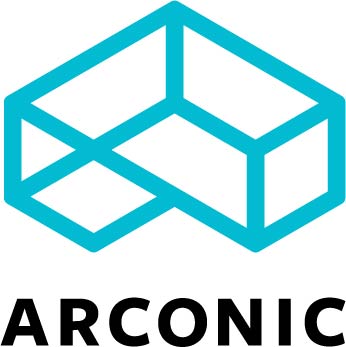

























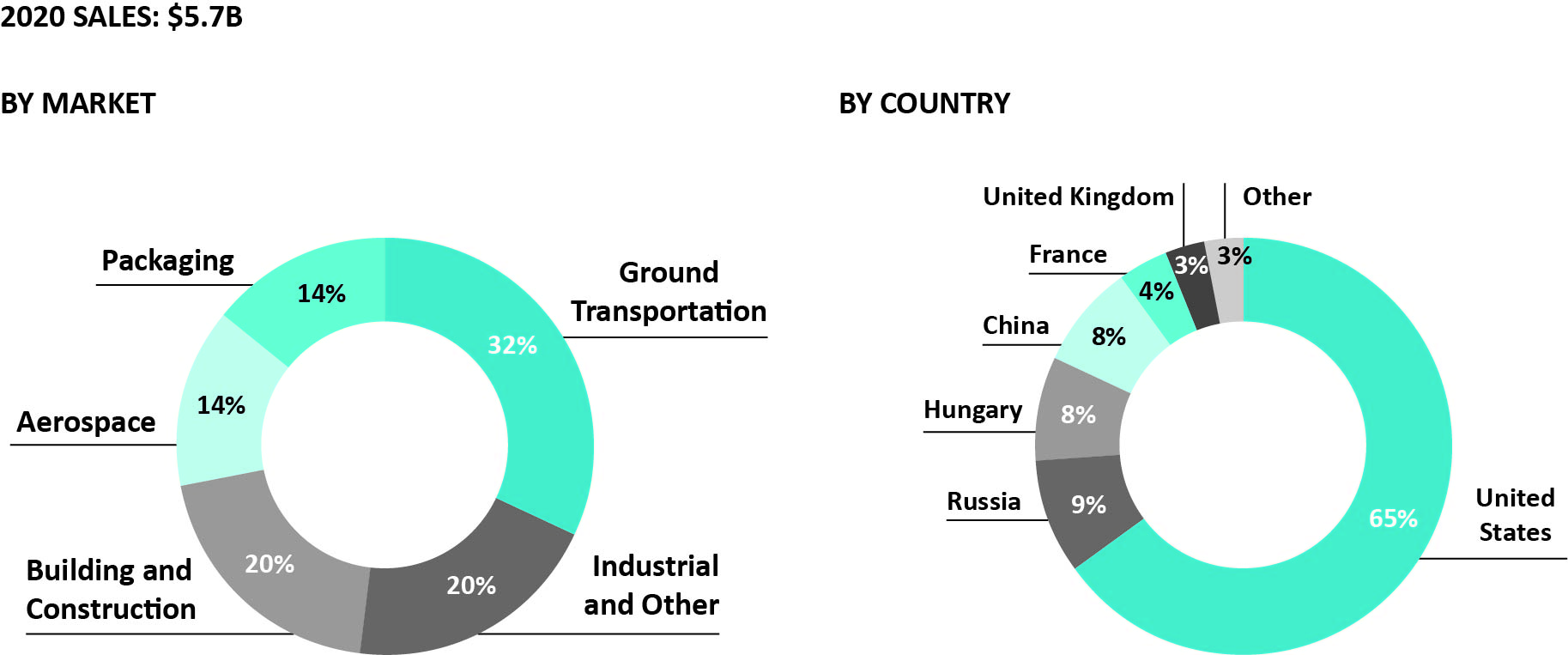


 We are committed to operating in a safe, responsible manner which respects the environment and the health of our employees, our customers and the communities where we operate worldwide. We have a robust environmental compliance program that emphasizes proactive identification of opportunities to reduce our impact, prompt implementation of effective management controls, and best-practice sharing.
We are committed to operating in a safe, responsible manner which respects the environment and the health of our employees, our customers and the communities where we operate worldwide. We have a robust environmental compliance program that emphasizes proactive identification of opportunities to reduce our impact, prompt implementation of effective management controls, and best-practice sharing.